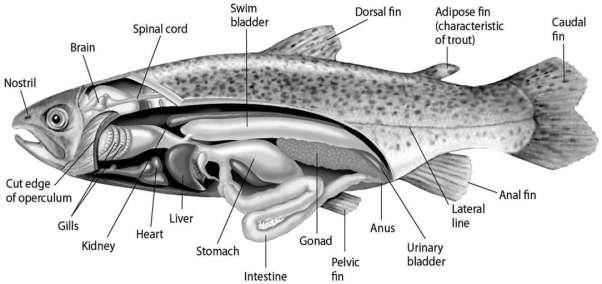Please use the following information to answer the questions below.
 Figure 27.2
Figure 27.2
Fishes that have swim bladders can regulate their density and thus their buoyancy.There are two types of swim bladder: physostomous and physoclistous.The ancestral version is the physostomous version,in which the swim bladder is connected to the esophagus via a short tube (Figure 27.2) .The fish fills this version by swimming to the surface,taking gulps of air,and directing them into the swim bladder.Air is removed from this version by "belching." The physoclistous version is more derived and has lost its connection to the esophagus.Instead,gas enters and leaves the swim bladder via special circulatory mechanisms within the wall of the swim bladder.
-The presence of a swim bladder allows the typical ray-finned fish to stop swimming and still
Definitions:
Word Usage
The manner in which words are employed to convey meaning in a specific context, often relevant in legal documents and proceedings.
Gender-neutral Substitute
Language or terminology used to replace gender-specific terms, promoting inclusivity and avoiding discrimination based on gender.
Sexist Language
Language that discriminates against a gender, often by stereotyping roles or using biased terms.
Legalese
Specialized language used in the legal profession characterized by complex vocabulary and syntax.
Q4: Adherence to the intestinal lining by this
Q19: Rhizobia,actinomycetes,and cyanobacteria all share the common feature
Q27: Plant biotechnology is an effective tool for<br>A)reducing
Q37: The nitrogenous waste that requires the most
Q39: The origin of a new plant species
Q46: What is the fate of a flaccid
Q49: Test tube 1 contains<br>A)Paramecium.<br>B)Navicula (diatom).<br>C)Pfiesteria (dinoflagellate).<br>D)Plasmodium.
Q53: Ammonia<br>A)is soluble in water.<br>B)can be stored in
Q61: What should be true of the cell
Q61: Which of the following synthetic auxin functions